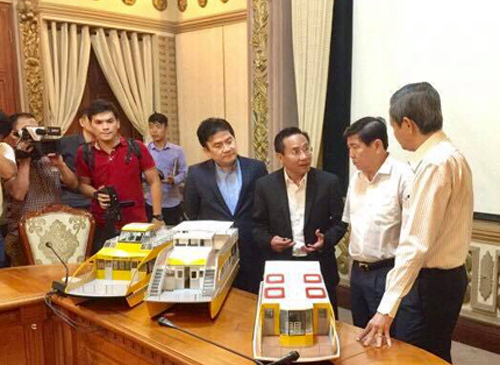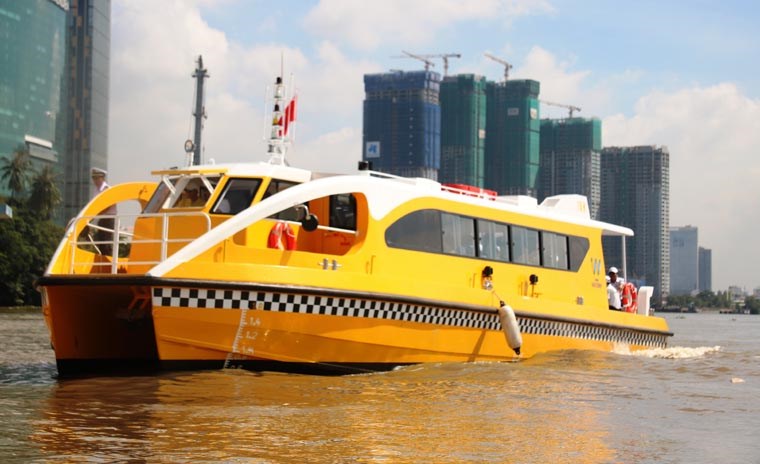SAIGON WATERBUS
Barbara Adam sits down with the head of the Saigon Waterbus company to learn more about Ho Chi Minh City’s newest mode of transport. Photos by Thang Pham.
The next big thing is finally here. The Saigon Waterbus is in operation, several months after its target launch date.
The first announcements about the service said it would start in August but it was late November before things finally got underway. For the first 10 days tickets were free, but very difficult to obtain. Many expats and locals eager to try the service were turned away during the first few weeks of operation, triggering a wave of online grumblings.
Saigon Waterbus is run by Daily Company Limited, a private company founded in 2006 by Nguyen Kim Toan, who still serves as the company’s director. In an interview with AsiaLIFE, Mr Toan acknowledged the waterbus had encountered some hiccups in its early days but the problems were being resolved.
Saigon Waterbus currently has five 80-seat boats dedicated to route 1. Four are in operation and one is held in reserve in case of a breakdown. Tickets are only VND15,000 for the entire route.
Route 2 will link Bach Dang Pier in District 1 to Lo Gom in District 6. However, the canal is blocked by a sewer construction, so the second waterbus can’t be launched until that is completed.
Mr Toan said a total of 10 piers had been built and were ready for operation. He said the company has a long-term plan to offer four different routes.
“Every station will become a window for the citizens to go everywhere, to travel and do business,” he said, through a translator.
“In Ho Chi Minh City there are more than 1,000 kilometres in the river and canal system,” Mr Toan said. “It’s a very great opportunity for us to travel through the city.”
Mr Toan said the original waterbus timetable was prepared with commuters in mind, but the company had since adjusted its focus to day-trippers.
“So we had to reschedule the timetable to serve the people who would like to experience the Saigon Waterbus once. And then in the future we would like to reschedule our timetable to serve people who go to work every day.”
“We have 13 million people (in Saigon) and if we just take 50% of them on the waterbus, we have more than 10 years of a market of people who want to take the waterbus at least once,” he said.
Mr Toan pointed out that even though the waterbus was a form of public transport, it was not subsidised by the Ho Chi Minh City government.
“In other countries if you travel by public transport, the city government subsidises the service,” Mr Toan said.
“In this project the city government is not sponsoring anything. We have invested by ourselves.”
Mr Toan said the city government’s support was crucial to the success of the waterbus service.
According to its website, Daily Co has previously invested in Dai Nam Park, a sprawling theme park in Binh Duong Province, and Happyland Park, a stalled project in the Mekong Delta’s Long An Province once touted as Southeast Asia’s biggest theme park.
Daily Co’s website says the company plans to expand into water-based tourism projects, including restaurant ships, hotels and luxury yachts.
There was a holiday atmosphere on board the Saigon Waterbus the day the AsiaLIFE team tested the route.
Passengers were excitedly chatting and pointing out landmarks to each other in the pristine air-conditioned cabin. On the back deck things were more subdued, possibly because the passengers gathered there were dignified older gents.
A group of nine retired teachers from District 3 were on board, also testing out the new service.
Waterbus’s route 1
The waterbus’s route 1 links downtown District 1 to Thu Duc District. At present there are only five stops: Bach Dang pier in District 1; Binh An pier in District 2; Thanh Da pier in Binh Thanh District; Hiep Binh Chanh in Thu Duc District; and Linh Dong pier, also in Thu Duc District.
It’s a short walk from Linh Dong pier to the Binh Quoi ferry, which can take you to Binh Quoi Village 2, one of Ho Chi Minh City’s green and serene tourist villages. Binh Quoi Village 2 has a restaurant, swimming pool and tennis courts. Nearby Binh Quoi 1 has a larger restaurant and family activities, and is a short bus ride away.
Saigon Waterbus has a helpful map showing the bus routes that link to its piers. From the Binh Quoi villages, you can take bus number 44 along Binh Quoi Street, through Binh Thanh District, right to the Ben Thanh Market in District 1.
The map also recommends using the waterbus and bus combo to “explore the Thanh Da Peninsula”, and includes some must-try local dishes such as Thanh Da rice soup with boiled duck.
“It’s new so we wanted to try it,” group leader Dang Thuy Dung told AsiaLIFE through an interpreter.
The group gave the waterbus a big thumbs up, even though they were disappointed by the lack of shopping opportunities at the final stop, Linh Dong pier.
They weren’t aware that the Linh Dong station is linked to Binh Quoi Tourist Village by a regular ferry. But Dung said the group would return in the future to spend a day at Binh Quoi.
“Today was just for fun,” she said. “We just tried it for the experience.”
Australian Sue Wise has been taking the waterbus since it began operating to commute from her home in Thanh Da to her office in District 1.
“I actually love it,” Sue said. “It’s a really peaceful, non-stressful way to travel and the waterbus leaving D1 at 5.30 offers amazing views of the city.”

https://www.asialifemagazine.com/vietnam/saigon-waterbus/ |









